Physical Address
304 North Cardinal St.
Dorchester Center, MA 02124
A variety of organisms can infect the female genital tract, accounting for considerable suffering and morbidity ( Table 4.1 ). Some, such as candidal infections, trichomoniasis, and bacterial vaginosis, are extremely common and may cause significant discomfort, but with no serious sequelae. Others, such as gonorrhea and chlamydial infection, are major causes of female infertility. Viruses, principally human papillomavirus (HPV), are involved in the pathogenesis of vulvar, vaginal, and cervical cancers. Many infections are sexually transmitted, including trichomoniasis, gonorrhea, chancroid, granuloma inguinale, lymphogranuloma venereum, syphilis, chlamydia, herpes, and HPV.
| Infections | Class of Microbes | Infectious Agent in the Genital Tract |
|---|---|---|
| Common | ||
| Pediculosis pubis (crab lice) | Ectoparasite | Phthirus pubis |
| Scabies | Ectoparasite | Sarcoptes scabiei var. hominis |
| Vulvovaginal candidiasis | Fungus | Candida spp. (most common— Candida albicans ) |
| Tinea cruris | Fungus | Dermatophyte |
| Bacterial vaginosis | Bacteria | Shift in vaginal flora, resulting in decrease in lactobacilli and increase in anaerobes |
| Folliculitis | Bacteria (most common) | Staphylococcus aureus (most common) |
| Sexually Transmitted | ||
| Trichomoniasis | Protozoan | Trichomonas vaginalis |
| Molluscum contagiosum | Virus | Molluscipoxvirus genus |
| Herpes simplex virus (HSV) | Virus | HSV-2 (more common) or HSV-1 |
| Gonorrhea | Bacteria | Neisseria gonorrhoeae |
| Syphilis | Bacteria (spirochete) | Treponema pallidum |
| Chancroid | Bacteria | Haemophilus ducreyi |
| Granuloma inguinale | Bacteria | Klebsiella granulomatis |
| Lymphogranuloma venereum | Bacteria | Chlamydia trachomatis |
| Rare | ||
| Schistosomiasis | Helminth (Trematodes) | Schistosoma haematobium (most common at this location) |
| Epstein-Barr virus (EBV) | Virus | EBV |
| Periclitoral abscess (less common) | Bacteria | No specific single agent; often polymicrobial |
| Usually Seen in the Immunosuppressed Patient a | ||
| Tuberculosis | Bacteria | Mycobacterium tuberculosis (most common) |
| Bacillary angiomatosis | Bacteria | Bartonella henselae or Bartonella quintana |
| Necrotizing fasciitis | Bacteria | No specific single agent; often polymicrobial |
| Chronic herpes simplex virus (HSV) | Virus | HSV-2 or HSV-1 |
| Varicella-zoster virus (VZV) | Virus | VZV |
| Disseminated molluscum | Virus | Molluscipoxvirus genus |
| Crusted (Norwegian) scabies | Ectoparasite | Sarcoptes scabiei var. hominis |
| Extensive genital warts | Virus | Human papillomavirus |
This chapter focuses on pathogens encountered principally in the lower genital tract—vulva, vagina, and cervix. Those involving the upper genital tract will be described in the discussion of the the fallopian tube (see Chapter 20 ). Papillomavirus infections (condylomata) are discussed in Chapters 6 and 13 .
Many of the common infections discussed in this chapter are so-called clinician's diseases, meaning that the diagnosis and treatment are carried out exclusively by the clinician, and the role of the anatomic pathologist is largely confirmatory. Many disorders, such as candidiasis, bacterial vaginosis, and common sexually transmitted diseases (STDs), do not require the expertise of a diagnostic surgical pathologist. For others, such as clinically unsuspected candidiasis, syphilis, or other rare STDs such as tuberculosis and bacillary angiomatosis, recognition by the pathologist may be key to diagnosis and treatment (see Table 4.1 ). Biopsy may also be warranted if the clinical presentation is atypical, or the prescribed treatment is not effective.
Treatment of these disorders will be summarized, where appropriate. For treatment specifics for STDs, the Centers for Disease Control and Prevention (CDC) has developed an STD treatment guideline. In many of the diseases discussed, additional information relevant to the human immunodeficiency virus (HIV)–positive population can be obtained via online courses offered by tertiary institutions.
Pediculosis pubis is caused by an ectoparasite, Phthirus pubis, also known as the crab louse. Patients present with pruritus in the pubic area. Transmission is by direct intimate contact. The parasites are 1 to 3 mm long and have three pairs of legs. They can be seen with the naked eye and appear as brown-gray specks attached to the pubic hair base. They infest hair in the pubic area and occasionally other body areas that contain terminal hairs. The life cycle of the female is 1 to 3 months. The adult female lays eggs (nits) that adhere to hair at the skin-hair junction. A nit may be seen as a small opalescent gray speck connected to the hairs ( Fig. 4.1 ) and hatch in 6 to 10 days. Nymphs then mature to adults within 10 to 14 days. Pediculosis pubis is diagnosed by the identification of live lice or viable nits.
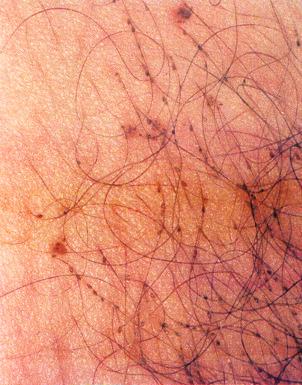
All patients with pediculosis pubis should have a thorough investigation for other STDs because co-infection can occur, and screening for HIV, syphilis, gonorrhea, chlamydial infection, herpes, warts, and trichomoniasis should be considered in this patient population.
Physical examination reveals visible opalescent nits or live lice and blue macules (maculae caeruleae) at feeding sites.
Patients with pubic lice usually seek medical attention because of pruritus or because they notice lice or nits on their pubic hair. The vulvar lesions can be scraped onto a slide and the contents viewed under a microscope in the clinic. The entire crab louse can be visualized; it contains three pairs of legs. In contrast to the oval shape of head and body lice, the crab louse is almost as wide as it is long, allowing it to grasp pubic hairs with a large diameter.
In contrast to ticks, lice do not stay attached to their host after feeding and thus are seldom identified on skin biopsies. It is worth noting, however, that the histopathology of P. pubis may be virtually identical to that of the larvae of Amblyomma and Ixodes ticks, according to one case study. On hematoxylin and eosin (H&E) preparations, sections of crab lice (and the aforementioned ticks) show a chitinous body with striated muscle, may contain red blood cells, and may have pigmented mouth parts. Therefore, crab louse infestation should be considered when a small arthropod is encountered in a biopsy. Detailed analysis on gross examination may then allow definitive identification.
The clinical differential diagnosis of pediculosis pubis includes dermatophyte infection, folliculitis, and contact dermatitis. Scabies can cause similar symptoms of pruritus and excoriations in the pubic area. However, mites are not visible with the naked eye, and nits are absent in scabetic infestation.
Treatments are primarily topical. Decontamination of clothing and bedding, with avoidance of sex partners until the infestation is eliminated, are helpful for control.
Scabies is an infection caused by Sarcoptes scabiei var. hominis (itch mite). Its mode of transmission is via skin contact. It can also be transmitted from bed linens or clothing. Scabies in adults is often sexually acquired. However, scabies in children is not usually sexually acquired. The greatest worldwide burden is seen in children. Sensitization to S. scabiei must occur before pruritus begins. The first time a person is infected with S. scabiei , sensitization takes as long as several weeks to develop. However, pruritus might occur within 24 hours after a subsequent re-infestation.
Hypotheses have been proposed about the delay in onset of symptoms in a primary infestation—one is that the mites secrete immunomodulatory molecules (e.g., complement inhibitors), suppressing the early immune response in the host. Recent studies have also suggested that the presence of these inhibitors in mite fecal pellets may have a local effect on growth of the skin-associated bacteria, which in turn contributes to a complex interaction among mites, host, and the local microbiome.
A small burrow is found on the skin during an infection, appearing as wavy gray-brown lines. A predilection has been reported for the soles, wrists, skin folds such as nipples, inframammary folds, waist, and genitalia. The mite may be visualized in early disease as a tiny dot at the end of the burrow. The predominant symptom of scabies is pruritus, which is generally worse at night, and a maculopapular rash ( Fig. 4.2 ). Excoriations due to scratching are common and often complicate the clinical examination.
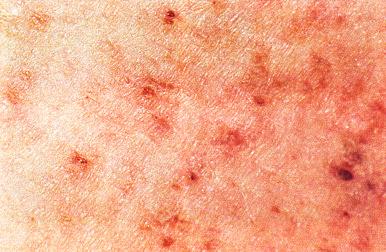
Diagnosis can be confirmed by scraping the lesion onto a slide and viewing it with a microscope. When scraping, papules or burrows that have not been scratched or disturbed should be selected. Crusted scabies (e.g., Norwegian scabies) is a florid infestation that usually occurs in immunodeficient, debilitated, or malnourished persons (see later, “ Common and Rare Vulvar Infections Associated with Immune Suppression ”).
The lesions of scabies are occasionally biopsied when clinical diagnosis cannot be confirmed. The female mite body is rounded and smaller than 0.5 mm in diameter. A definitive diagnosis requires demonstration of the mite body, which can be performed with a hand lens or histologic preparations from skin scrapings. Microscopic examination of skin usually reveals acanthosis with variable hyperkeratosis and spongiosis, sometimes with exocytosis of eosinophils or neutrophils ( Fig. 4.3A ). Special stains may be needed to rule out fungal infection. Superficial and deep perivascular nodules of lymphocytes are seen, often admixed with histiocytes and eosinophils. In persistent nodular scabies, the density of the infiltrate and scattered atypical lymphoid cells can create concern for lymphoma. Serial sections can be used to search for a burrow through the stratum corneum and mite body parts, eggs, or fecal deposits (scybala) in the stratum granulosum or spongiosum (see Fig. 4.3B ). In the absence of diagnostic organisms, scabies infestation can be suggested to the clinician when this pattern of lymphocytic infiltration is seen in an appropriate clinical setting.
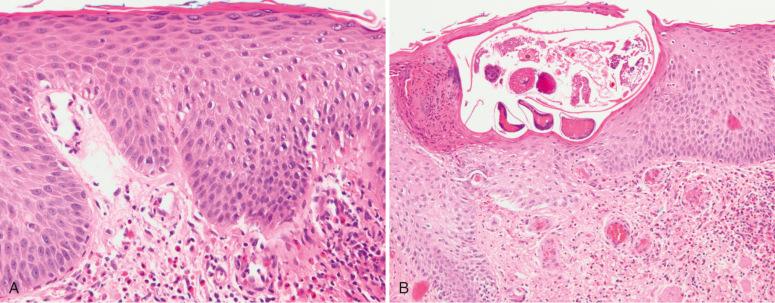
The crusted variant of scabies (so-called Norwegian scabies) shows exuberant hyperkeratosis with parakeratosis and mites, and their eggs are usually numerous.
The diagnosis of scabies can be complicated by atypical clinical manifestations, low mite burdens, and morphologic and clinical overlaps with other skin diseases. The clinical differential diagnosis for scabies includes arthropod bites, atopic or contact dermatitis, psoriasis, lichen planus, impetigo, pediculosis pubis, lichen simplex chronicus, prurigo nodularis, seabather's eruption, fungal infections, and drug reactions. The presence of scabies mites, eggs, or scybala is key to a definitive pathologic diagnosis; however, searching for these diagnostic elements is often fruitless, even with exhaustive serial sectioning, in which case clinical correlation is needed in the context of pathologic findings.
As discussed previously, treatment is primarily topical. Bedding and clothing should be decontaminated. Both sexual and close personal or household contacts within the preceding month should be examined and treated.
Candida spp. are the most common cause of fungal infection in humans, and vulvovaginal candidiasis (VVC) is the most common form of mucosal candidiasis. Although most cases of VVC (up to 90%) are caused by Candida albicans , the incidence of VVC caused by non- albicans species (10%–30%) such as Candida glabrata (second most common causative organism), Candida parapsilosis , Candida tropicalis , Candida lipolytica , Saccharomyces cerevisiae, and others, appears to be rising. Recognition of these non- albicans species is important because they can be more resistant to the traditionally used azole antimycotics.
VVC is uncommon before menarche, with a rapidly increasing incidence late in the second decade, peaking in the third and fourth decades. In North America, three of four women will experience at least one episode of VVC, and 50% of women will experience more than one episode. For a smaller percentage of women (~5%–10%), the condition will become chronic, with multiple relapses over several years. It has been estimated that over 80% of recurrent VVC cases were caused by azole-sensitive C. albicans , suggesting that host factor(s) rather than pathogen resistance contribute to the development of recurrent infections.
Predisposing factors for VVC include uncontrolled diabetes mellitus, immunosuppressed state, pregnancy, steroid and antibiotic use, oral contraceptive use, use of an intrauterine device, and postmenopausal state. It should be noted that Candida spp. are commensal organisms that can be part of the mucosal normal flora. Their presence is not necessarily indicative of disease but may only be colonization. As many as 20% of women are asymptomatic carriers of candidal species, with the proportion rising to 30% in pregnancy. Vulvar involvement in the absence of vaginal infection is rare.
The most common symptoms and signs are intense vulvar pruritus, dysuria, erythema, edema, and a nonmalodorous white vaginal discharge with a curdlike appearance ( Fig. 4.4A and B ).
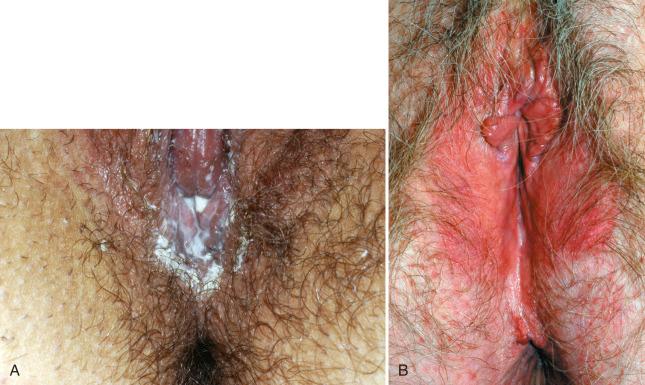
Diagnosis is usually established by assaying the vaginal pH, a potassium hydroxide (KOH) prep, or fungal cultures. In VVC, the vaginal pH is almost always normal, although an elevated pH may suggest mixed infection. A KOH prep and microscopy are helpful but sensitivity can be low and variable (≈40%–70%). If microcopy is negative and the vaginal pH is normal, the culture should be obtained. When a clinician obtains a fungal culture, the vulva as well as the vagina should be swabbed. A yeast culture with identification of species is often helpful when treating patients with recurrent vulvovaginitis.
Candida infections are usually associated with hyperkeratosis or parakeratosis, epidermal hyperplasia (often psoriasiform), and a suppurative inflammation, with neutrophil infiltration of the squamous epithelium typically forming microabscesses ( Fig. 4.5A and B ). Candida may be seen with minimal inflammation when there is no mucosal invasion. The pseudohyphal and budding yeast forms of Candida can be highlighted in the epidermis using periodic acid–Schiff (PAS) or silver stains (see Fig. 4.4C ). Candida spp. are also positive for Gram stain, which is helpful in distinguishing it from other, albeit rare, reported fungal infections of the lower genital tract (see later, “ Other Uncommon Fungal Agents Detected in the Lower Genital Tract ”).
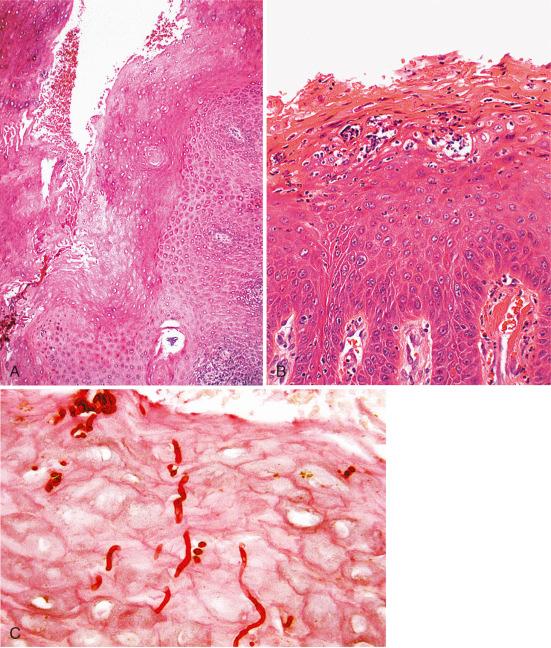
C. albicans and C. glabrata , the two most common causative species of VVC, can be differentiated histologically because C. glabrata demonstrates yeast forms and lacks pseudohyphal production in the vast majority of cases. The various other species of Candida cannot be differentiated by light microscopy.
It is important to note that fungal infections may have been previously treated by antifungals, steroids, or both at the time of biopsy and may affect the histologic features. In particular, steroid use may reduce the neutrophilic infiltrate. In a histologic section or Papanicolaou (Pap) smear, mucosal fungal infections may be associated with reactive changes of squamous epithelium, such as enlarged hyperchromatic nuclei, which can mimic squamous intraepithelial lesions.
The histologic differential diagnosis of candidal infection includes eczematous dermatitis, lichen simplex chronicus, intertrigo, and psoriasis (see Chapter 2 ; Box 4.1 ). Before making any of these diagnoses, PAS or silver stain should be used to exclude a fungal infection. Lichen simplex chronicus may also be superimposed on a candidal infection as a result of rubbing to relieve the pruritus. It is important to note that fungal superinfection may occur in many other lesions. In cases in which the underlying diagnosis is unclear and might be complicated by superimposed infection, it is wise to advise the clinician to treat the fungal infection and repeat the biopsy if the lesion persists.
Eczematous dermatitis
Lichen simplex chronicus
Intertrigo
Psoriasis
Intraepithelial neoplasia
It is necessary to consider removal or improvement of predisposing factors in the treatment of candidiasis. Topical antifungal agents are the mainstay of therapy, and numerous preparations are available.
Tinea cruris (jock itch) is a dermatophytic infection of the groin and pubic region. It is more common in men than in women and is acquired by contact. It is not often seen on the vulva or around the anus.
The prevalence of specific dermatophyte species is dependent on geographic location. Trichophyton rubrum , Trichophyton tonsurans , and Trichophyton mentagrophytes are some of the species that cause this condition. Other organisms, including Epidermophyton floccosum and Trichophyton verrucosum , cause an identical clinical condition.
A person in an immunocompromised state (e.g., as seen in those with HIV or diabetes or patients who have had a transplant) is associated with risk of infection and dissemination. Disseminated dermatophytosis due to hematogenous spread can cause symptoms in any organ.
The signs and symptoms of tinea cruris include itching and erythema in the groin, vulva, inner thighs, anus, and buttocks. The lesions are erythematous, with central clearing and raised borders. The skin may flake, crack, and peel. A burning sensation may be present.
The diagnosis of tinea cruris is generally confirmed by culture and microscopy of skin scrapings treated with KOH to visualize the hyphae.
The epidermis exhibits spongiosis or a psoriasiform pattern of hyperplasia. A granulomatous dermatitis may accompany folliculitis (Majocchi granuloma). A diagnostic clue is the presence of neutrophils in the cornified cell layer, and fungal elements can be sandwiched between two zones of differing structure within the cornified cell layer—this is sometimes referred to as the sandwich sign. The upper zone of the cornified cell layer has a typical basket weave pattern of orthokeratosis, whereas the lower zone consists of more compact orthokeratosis and parakeratosis. The presence of spores and branching hyphae can be confirmed using PAS or methenamine silver stains, but histologic examination provides no clues regarding the dermatophyte species.
The following conditions should be considered in the clinical differential diagnosis of tinea cruris: acanthosis nigricans, eczematous dermatitis, including contact dermatitis (allergic and irritant), erythrasma folliculitis, psoriasis, candidal infection, and seborrheic dermatitis.
Histologically, dermatophytic hyphae are often morphologically indistinguishable from those of Candida, as well as hyalohyphomycosis, which can involve any organ in disseminated disease in immunocompromised patients. Correlation with culture is needed for the definitive classification of the infectious agent in these cases.
Topical antifungal agents of the imidazole or allylamine family are generally used for the treatment of tinea cruris. At times, systemic administration of antifungals is needed for patients unable to use topical treatments consistently or those with extensive or recalcitrant infection.
Other fungal species uncommonly reported involving the lower genital tract (often on Pap smears or in the setting of disseminated disease) include Histoplasma , Cryptococcus , Aspergillus , Blastomyces , Coccidioides , and Paracoccidioides spp. These agents are seen more commonly at other anatomic sites. Contamination of specimens needs to be ruled out for proper evaluation. Table 4.2 shows the distinguishing features of these fungi, which can show morphologic overlaps with Candida spp.
| Associated Disease | Infectious Agent in Humans | Fungal Morphology on Pap Smear or Tissue Section | Typical Stains for Differentiation b |
|---|---|---|---|
| Common | |||
| Candidiasis | Candida spp. (most common: Candida albicans ) |
Small yeast cells (2–6 µm) intermingled with pseudohyphae | Gram stain (+) |
| Rare a | |||
| Blastomycosis | Blastomyces dermititidis | Spherical multinucleated yeast cells (8–15 µm), single broad-based budding, thick refractile wall | Gram stain (−), Fontana-Masson stain (−) |
| Histoplasmosis | Histoplasma capsulatum, Histoplasma duboisii | Oval small yeast cells (2–4 µm), narrow-based budding | Gram stain (−), Fontana-Masson stain (−) |
| Cryptococcosis | Cryptococcus neoformans, Cryptococcus gattii | Encapsulated spherical to oval yeast cells (5–10 µm), narrow-based budding, polysaccharide capsule | Fontana-Masson stain (+), mucicarmine and Alcian blue (+) in capsule |
| Aspergillosis | Aspergillus spp. (most common— Aspergillus fumigates ) | Septate hyphae (3–6 µm in diameter), dichotomous branching at 45-degree angle, fruiting body (mostly on Pap smears) | Gram stain (−), Fontana-Masson stain (−) |
| Coccidioidomycosis | Coccidioides immitis, Coccidioides posadasii | Large, thick-walled spherules (100 µm) containing endospores (≤5 µm) | Gram stain (−), Fontana-Masson stain (−) |
| Paracoccidioidomycosis | Paracoccidioides brasiliensis | Large round yeast cells (4–40 µm), multiple narrow-based budding conidia (ship's wheel appearance) | Gram stain (−), Fontana-Masson stain (−) |
a These fungal agents detected are mostly contaminants or seen in the setting of disseminated disease. Isolated involvement of the lower female genital tract is extremely rare.
b Fungal elements are positive for GMS and PAS stains unless otherwise stated.
Various terms have been used to describe bacterial vaginosis (BV), including nonspecific vaginitis, Haemophilus vaginitis, Corynebacterium vaginitis, Gardnerella vaginalis vaginitis, and anaerobic vaginosis. Bacterial vaginosis represents a complex shift in the normal vaginal flora. It is characterized by a reduction in the prevalence and concentration of hydrogen peroxide–producing lactobacilli and an increase in the prevalence and concentration of a number of microbes that have been implicated in the disease process, including Gardnerella vaginalis , Atopobium and Mobiluncus spp., Mycoplasma hominis , anaerobic gram-negative rods belonging to the genera Prevotella , Porphyromonas , and Bacteroides, as well as Peptostreptococcus , Leptotrichia , and Sneathia spp. and BV-associated bacterium 1 (BVAB1) to BVAB3. It is thought that BV results from the presence of a multispecies vaginal biofilm in which G. vaginalis is the predominant species. G. vaginalis has been detected in culture samples from nearly all symptomatic women with BV and in approximately 50% of the vaginal microflora of healthy women.
It has been estimated that about 20% to 30% of reproductive age women worldwide suffer from BV. Risk factors include the number of lifetime sex partners, early age of sexual debut, regular douching, and being a commercial sex worker. Associations of BV with other sexually transmitted diseases and health issues have been reported, (e.g., HIV, herpes simplex virus type 2 [HSV2], chlamydia, gonorrhea), as well as preterm births, and pelvic inflammatory disease. Although causality and underlying biologic mechanisms have not been established, studies have suggested that BV is a potential risk factor of acquisition of other sexually transmitted infections (STIs), particularly in high-risk women.
The patient presents with a foul, fishy odor, more noticeable following intercourse and during menses. Vaginal discharge is increased. Vulvar itching or irritation may be present.
Several testing schemes have been proposed for making a diagnosis of BV. Amsel et al. have proposed four criteria (Amsel criteria) in making a clinical diagnosis of BV. These have been slightly modified according to subsequent work by Eschenbach et al. to improve the accuracy of these criteria :
Thin, gray-white vaginal discharge
High vaginal pH (>4.5)
A cutoff of 4.7 or higher has been proposed and used to improve accuracy.
Positive whiff test
There is an accentuated malodorous fishy discharge on adding 10% KOH to a sample of vaginal discharge due to the production of amines (e.g., cadaverine, putrescine, triethylamine) by anaerobic bacteria; their concentrations increase by 100- to 1000-fold with BV.
Identification of vaginal epithelial cells (typically >20%) coated with bacteria (clue cells)
Because these markers are not consistent in all subjects with BV, criteria have been modified to include only the presence of clinical symptoms, and two of the three laboratory measures are thought to be acceptable for making a diagnosis of BV.
A Gram stain scoring system has been proposed by Nugent et al. in which increased densities of Gardnerella, Bacteroides, and Mobiluncus increase the score and density of Lactobacillus decreases the score. The Gram stain scoring system is more sensitive but less specific than the clinical criteria. The overall concordance between the Gram stain score and the Amsel criteria was reported to be about 80% to 90%.
A culture is not useful for making a diagnosis of BV, which represents a shift in vaginal flora. Cultures in past studies on BV have been shown to be positive for G. vaginalis in almost all women with symptomatic BV and in about 50% of healthy asymptomatic women ; hence, its presence alone cannot be used to diagnose BV.
Commercial tests, such as colorimetric molecular diagnostic tests using nucleic acid probes specific for G. vaginalis RNA, can give results within an hour (Affirm VPIII Microbial Identification Test, BD, Franklin Lakes, NJ), with good sensitivity (up to 95%) and specificity (up to 99%) using clinical criteria as the diagnostic standard. However, results can be variable based on the concentrations of G. vaginalis in the sample.
The Pap smear reveals clue cells in women with BV ( Fig. 4.6 ), which are squamous cells coated by a so-called shag rug of coccobacilli. Lactobacilli and white blood cells are absent, and neutrophils are often scarce. The number of clue cells should be more than 20% to increase the specificity of making a cytologic diagnosis of BV.
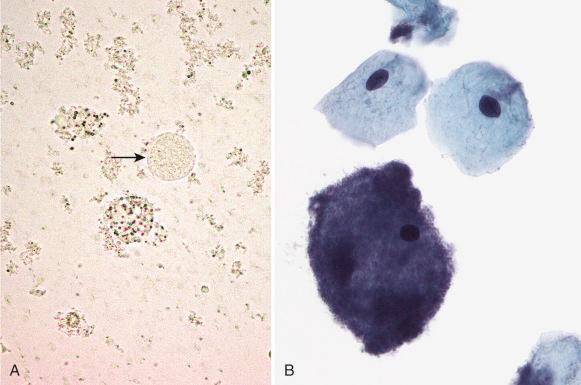
It should be noted that although a Pap smear diagnosis of BV has a high specificity (93%–95%), the sensitivity has been critiqued to be low (as low as 40%– 50%), and the absence of BV on a Pap smear does not necessarily rule out disease.
The clinical differential diagnosis for BV includes candidiasis, cervicitis, chlamydia, gonorrhea, herpes, trichomonas, and desquamative inflammatory vaginitis. These disorders are typically distinguished by appropriate analysis of the discharge and cultures.
Metronidazole and clindamycin are the mainstays of therapy. Antibiotics, however, are not useful for preventing recurrence due to antibiotic resistance and the inability of the antibiotics to fully eradicate the bacteria associated with the vaginal biofilm in BV.
An alternative approach for treating BV is by modulating the vaginal microbiota by using probiotics. Studies evaluating the efficacy of vaginal lactobacilli suppositories in addition to oral metronidazole for the treatment of BV have shown inconclusive results. Bacteriotherapy, using harmless bacteria (e.g., lactobacilli) to displace pathogenic organisms, is considered natural and without any side effects, but data from randomized controlled trials are mixed and have not yet shown definitive support for routine use.
Folliculitis is a common condition on the buttocks and vulva. The hair follicles can become inflamed by physical injury and chemical irritation. The most common form is superficial folliculitis, which manifests as a tender or painless pustule that heals without scarring. The hair shaft is frequently in the center of the pustule ( Fig. 4.7A ). The most common pathogen associated with folliculitis is Staphylococcus aureus , but commensal organisms such as yeast and fungi occasionally appear, particularly in the immunosuppressed patient. These lesions typically resolve spontaneously. Staphylococci will occasionally invade the deeper portion of the follicle, causing swelling, induration, and erythema, with or without a pustule at the skin surface (see Fig. 4.7B ). This inflammation of the entire follicle or the deeper portion of the hair follicle (isthmus and below) is called deep folliculitis.
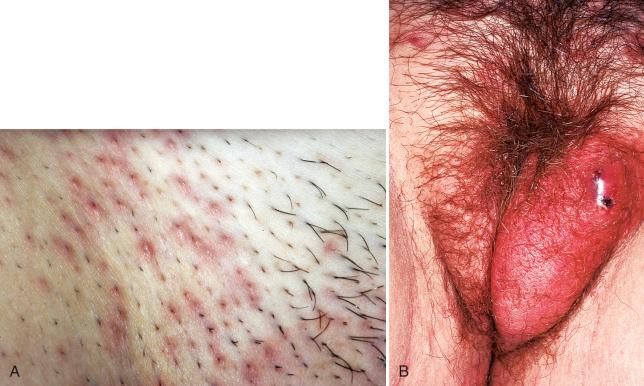
Visualization of erythema surrounding the hair follicles provides the clinical diagnosis of folliculitis.
Folliculitis is characterized by inflammation of the follicle or perifollicular stroma, which may be composed of acute or chronic inflammation. A granulomatous response can be seen with follicular rupture.
The clinical differential diagnosis of folliculitis includes acne vulgaris, candidiasis, irritant contact dermatitis, insect bites, keratosis pilaris, milia, miliaria, rosacea, scabies, seabather's eruption, tinea, and transient acantholytic dermatosis. Fungal folliculitis should be excluded with a PAS stain.
Topical antibiotics can be administered to accelerate the healing process of superficial follicultis. Oral antibiotics are generally used in the treatment of deep folliculitis.
Trichomonas vaginalis (TV) is caused by the flagellated protozoan Trichomonas vaginalis. It is a very common STD worldwide, more prevalent than Chlamydia trachomatis, Neisseria gonorrhoeae, and syphilis combined. The global prevalence has been estimated to be about 8% for women, which is possibly an underestimate because these were mostly based on microscopy rather than on the more sensitive nucleic acid amplification tests (NAATs). Rates of TV vary by populations according to their risk profiles. In the United States, a prevalence of 3.1% was reported in reproductive age women in general and 8% to 13% in women who went to antenatal or family planning clinics.
Infections may occur at any age. Risk factors include unprotected sexual activity, new or multiple sex partners, concurrent STIs, or a history of other STIs. A higher prevalence was also observed among African women, commercial sex workers, and women with bacterial vaginosis. Association of TV with other STIs, such as herpes infections, chlamydia, gonorrhea, and syphilis, as well as pelvic inflammatory disease and a poor pregnancy outcome (e.g., preterm labor and premature rupture of membranes), have been reported. TV has also been suggested in studies to increase the risk of HIV acquisition.
About 50% to 80% of women with trichomoniasis are asymptomatic. Symptoms and signs of trichomoniasis include a purulent, yellow-green, vaginal discharge and vaginal discomfort. In a subset of patients with acute infection, the underlying vaginal and cervical mucosa may have a grossly visible fiery red appearance, so-called strawberry cervix (colpitis macularis; Fig. 4.8 ). The vulva may be erythematous and edematous.
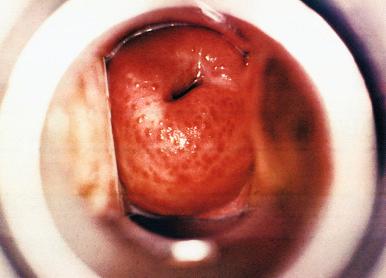
The diagnosis of VT is clinically confirmed by a wet mount consisting of microscopy of vaginal secretions. The vaginal pH is alkaline (>4.5) VT in patients. T. vaginalis is a flagellated ovoid protozoan (average length, 10 µm; width, 7 µm), which is motile, with a jerky spinning motion seen on wet mounts. The sensitivity of wet mounts depends on the inoculum size and can be variable and low. Alternative point of care test kits are available for clinicians' use with vaginal swabs. They are rapid antigen tests (e.g., OSOM Trichomonas Rapid Test), or use DNA hybridization probes (e.g., AFFIRM VP III), with good sensitivity and specificity.
T. vaginalis can also be detected by commercial NAATs, which detect the organism's RNA using a polymerase chain reaction (PCR) assay. They are highly sensitive and specific and are accepted as the gold standard for T. vaginalis detection.
Culture is another method for detecting the organism when the wet mount is negative and clinical suspicion remains high. The traditional diamond broth medium or its variant is used. Although culturing is highly sensitive and specific, it generally takes a few days (2–7) to obtain results. An InPouch culture system (BioMed Diagnostics, White City, OR) has been developed, with a quicker turnaround time (≤3 days).
On histologic section, the findings are nonspecific. The inflammatory reaction is usually limited to the mucosa and immediately subjacent lamina propria. Pap smears done for routine screening can incidentally detect T. vaginalis . The organisms typically present as oval, pear- or kite-shaped, protozoa, with eosinophilic cytoplasmic granules and vesicular nuclei ( Fig. 4.9 ).
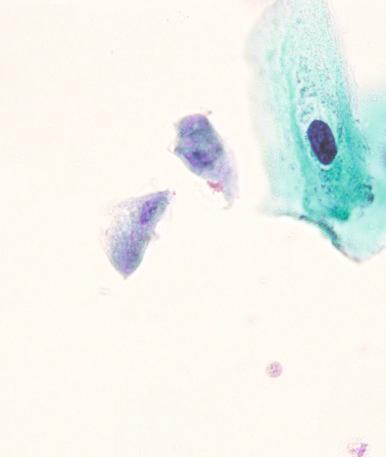
The clinical differential diagnosis of trichomoniasis includes candidiasis, bacterial vaginosis, desquamative inflammatory vaginitis, gonococcal infections, pelvic inflammatory disease, and urethritis.
Anti-infective agents are used to treat trichomoniasis. Treatment of patients and their sex partners results in relief of symptoms, microbiologic cure, and reduction of transmission.
Molluscum contagiosum (MC) is a viral disease of the skin and, occasionally, the mucosa. It is caused by a DNA poxvirus, molluscum contagiosum virus (MCV), which is the sole member of the Molluscipoxvirus genus. There are four main subtypes of molluscum contagiosum—MCV-I, -II, -III, and -IV —identified by restriction fragment length polymorphisms of their genomes. MCV-1 is the most common subtype in immunocompetent patients, and MCV-2 has been reported to be more common in HIV-infected patients. Direct contact with infected hosts or contaminated fomites is required for transmission. It can affect the genital area and is associated with a variety of other venereal diseases. As such, it is an STD often seen in sexually active populations.
In addition to sexually active adults, the disease is seen predominantly in children and immunodeficient individuals, such as HIV-positive patients, patients on immunosuppressive drugs, and patients with DOCK8 deficiency. It is an autosomal recessive disease affecting the migration of dendritic and specialized T cells in skin, resulting in an increased propensity to develop extensive MCV lesions as well as other bacterial and viral skin infections. The incubation time for MCV is variable, and symptoms typically present within a few weeks of inoculation.
MCV infection and proliferation usually remains limited to the keratinocytes, and there is little inflammatory infiltration of the epidermis although, when the virus is exposed, a host immune response is launched. The initial absence of an immune response to MCV is thought to be due to the activity of host response evasion genes in the viral genome that block apoptosis and natural killer cell activity.
The clinical appearance of MC is diagnostic in most cases. The characteristic lesion is a discrete, dome-shaped, flesh-colored papule ( Fig. 4.10 ). Some will contain a dimple beneath, which is a core of cheesy material (umbilicated lesion). The size of the papule ranges from 2 to 6 mm. Less commonly, the molluscum lesion will consist of numerous small confluent papules, mimicking herpes simplex virus infection. The lesions are usually painless except when traumatized.
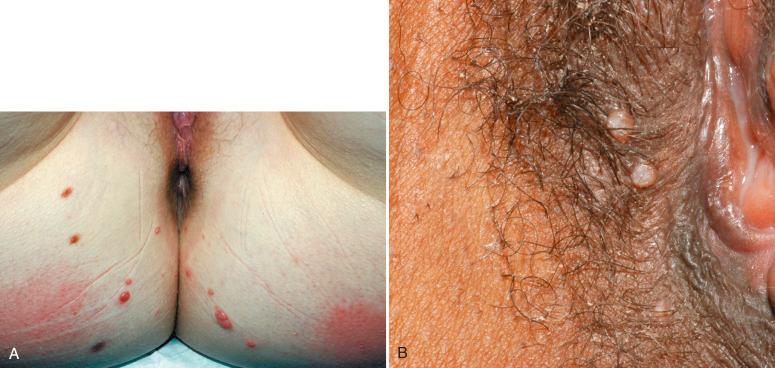
The diagnosis of MC can be confirmed by excision of the lesion or by cytologic inspection of the debris that is expressed from the center of the lesion and visualized on an H&E or Pap stain. The infection produces an epithelial hyperplasia, with formation of a cup-shaped lesion ( Fig. 4.11A ). The periphery of the cup contains several layers of basal cells, which mature centrally, shedding keratinous debris into the lumen or cavity that connects to the surface. Diagnostic viral inclusion bodies (Henderson-Patterson or molluscum bodies) become visible several layers above the basement membrane and, as the cells mature, the eosinophilic or cyanophilic oval viral inclusions (molluscum bodies) completely replace the cytoplasm and marginate the nucleus (see Fig. 4.11B ). In ruptured lesions, a marked inflammatory response can obscure the diagnostic viral cytopathic changes. In situ hybridization for MC virus DNA has also been performed but is not necessary for diagnosis.
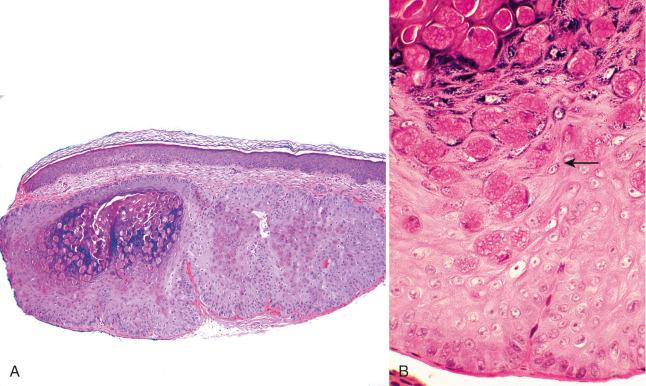
The clinical differential diagnosis includes acrochordon, epidermal inclusion cyst, dermatitis herpetiformis, keratoacanthoma, neurofibroma, condyloma, pyogenic granuloma, herpes, basal cell carcinoma, and disseminated cryptococcosis or penicilliosis.
In our experience, some difficulty may be encountered in the histologic diagnosis if the inclusions are not in the plane of section or the lesion is markedly inflamed. For this reason, any inverted or cup-shaped lesion that does not contain sufficient atypia to verify condyloma, keratoacanthoma, or other keratoses should be sectioned thoroughly to exclude MC.
Become a Clinical Tree membership for Full access and enjoy Unlimited articles
If you are a member. Log in here